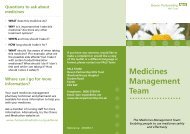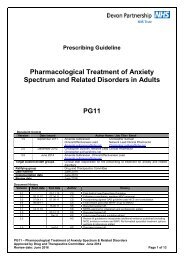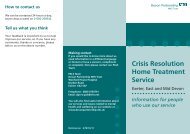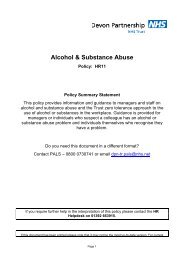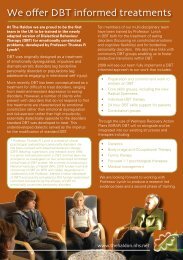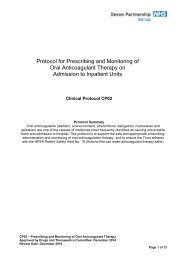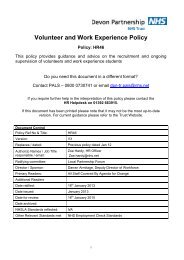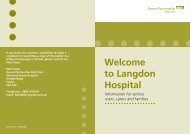CP04 Insulin and Blood Glucose - Devon Partnership NHS Trust
CP04 Insulin and Blood Glucose - Devon Partnership NHS Trust
CP04 Insulin and Blood Glucose - Devon Partnership NHS Trust
You also want an ePaper? Increase the reach of your titles
YUMPU automatically turns print PDFs into web optimized ePapers that Google loves.
Prescribing <strong>and</strong> Administrating <strong>Insulin</strong><br />
<strong>and</strong><br />
Monitoring <strong>Blood</strong> <strong>Glucose</strong> Levels<br />
Clinical Protocol <strong>CP04</strong><br />
Protocol Summary<br />
The prescribing of all medicines on inpatient units should be recorded on the <strong>Trust</strong><br />
Prescription <strong>and</strong> Administration chart. Additional specialist charts are to be used for<br />
high risk medication with variable dosing. This protocol provides guidance on how to<br />
complete the Diabetes Chart (F11) that must be used for the prescribing <strong>and</strong><br />
administering of insulin <strong>and</strong> for monitoring blood glucose.<br />
<strong>CP04</strong> Prescribing <strong>and</strong> Administering <strong>Insulin</strong> <strong>and</strong> Monitoring <strong>Blood</strong> <strong>Glucose</strong><br />
Approved by Drug <strong>and</strong> Therapeutics Committee: April 2014<br />
Review Date: April 2016<br />
1 of 9
Document Control<br />
Version Date Issued Author Name / Job Title / Email<br />
1.0 March 2010<br />
2.0 November 2010 Deborah Marriott (Network Lead Clinical Pharmacist)<br />
3.0 September 2012 deborah.marriott@nhs.net<br />
4.0 February 2013<br />
5.0 April 2014 Rosalind Gittins (Lead Clinical Pharmacist (Specialist Services))<br />
rgittins1@nhs.net<br />
Target audience/ staff groups: Clinical staff - all in-patient staff responsible for the prescribing <strong>and</strong><br />
administration of insulin <strong>and</strong> the monitoring of blood glucose<br />
Ratifying Group:<br />
Drug <strong>and</strong> Therapeutics Committee<br />
Date ratified: April 2014<br />
Implementation date: May 2014<br />
Review date: April 2016<br />
Document History<br />
Version Start date End date Author History<br />
1.0 March 2010 DM First version of Protocol signed off<br />
1.1 June 2010 October 2010 DM Protocol updated in response to NPSA Rapid Response Report<br />
‘Safer Administration of <strong>Insulin</strong>’.<br />
1.1 October 2010 October 2010 DM Working group set up (invites sent out through Heads of Services<br />
<strong>and</strong> Clinical Leads for each Directorate)<br />
1.2 November<br />
2010<br />
November<br />
2010<br />
DM<br />
Received comments from C Dixon, V Ford, Debbie Ashton<br />
(MMLP) <strong>and</strong> RLS. Concluded that more space needed on form<br />
for time <strong>and</strong> date.<br />
1.2 November<br />
2010<br />
November<br />
2010<br />
DM Included information received from Richard Beaumont (Pathology<br />
Lead for <strong>Blood</strong> <strong>Glucose</strong> Monitoring at RD+E<br />
2.0 November<br />
2010<br />
November<br />
2010<br />
DM Document ratified at Medicines Governance Group on 18 th<br />
November 2010<br />
2.1 July 2012 July 2012 DM Updated to include <strong>Insulin</strong> Passport, reference to Rio, <strong>and</strong><br />
comments received regarding last version of the document.<br />
3.0 Sept 2012 KS Document signed off<br />
3.1 Oct12 DM References to use of glucagon removed<br />
4.0 Feb 2013 KS Document signed off<br />
4.1 Feb-14 RG Changes made to SOP <strong>and</strong> form F11 due to new insulin injection<br />
devices being used.<br />
4.1 May14 DM Checked HBA1C levels to national guidance<br />
5.0 May14 KS Document ratified at DTC <strong>and</strong> signed off.<br />
Document Working Group<br />
VERSION 4.0 Adult services Older People’s<br />
Services<br />
Directorates<br />
Medicines Management<br />
Other<br />
Specialist<br />
Services inc LD<br />
Secure Services<br />
All Pharmacists <strong>and</strong> Technicians<br />
Marie Dougal-Johnson Diabetes Specialist Nurse at RD&E , Sam Rosindale Diabetes<br />
Lead Champion Torbay Care <strong>Trust</strong>, Gayle Richards Lead Diabetes Specialist Nurse,<br />
NDDH- contacted but no response received<br />
<strong>CP04</strong> Prescribing <strong>and</strong> Administering <strong>Insulin</strong> <strong>and</strong> Monitoring <strong>Blood</strong> <strong>Glucose</strong><br />
Approved by Drug <strong>and</strong> Therapeutics Committee: April 2014<br />
Review Date: April 2016<br />
2 of 9
Prescribing <strong>and</strong> Administering <strong>Insulin</strong> <strong>and</strong> Monitoring <strong>Blood</strong> <strong>Glucose</strong><br />
1. Scope, general responsibilities <strong>and</strong> training requirements<br />
This protocol applies to all staff who are responsible for ordering, storing, h<strong>and</strong>ling, prescribing or<br />
administering <strong>Insulin</strong>. It also applies to staff who monitor blood glucose levels.<br />
Between November 2003 <strong>and</strong> November 2009, over 16,000 incidents involving insulin were reported<br />
to the National Patient Safety Agency (NPSA), resulting in several deaths <strong>and</strong> serious harm. An alert<br />
was issued in 2010 that directed that all Healthcare Professionals (HCPs) involved in prescribing,<br />
dispensing or administering insulin should complete the <strong>NHS</strong> Diabetes e-learning package (see<br />
Online course programme).<br />
In 2011, the NPSA published another alert with the following st<strong>and</strong>ards to be implemented in all<br />
health organisations by 31 st August 2012:<br />
1. Adult patients on insulin therapy receive a patient information booklet <strong>and</strong> an <strong>Insulin</strong> Passport<br />
to help provide accurate identification of their current insulin products <strong>and</strong> provide essential<br />
information across healthcare sectors.<br />
2. Healthcare professionals <strong>and</strong> patients are informed how the <strong>Insulin</strong> Passport <strong>and</strong> associated<br />
patient information can be used to improve safety.<br />
3. When an <strong>Insulin</strong> is prescribed, dispensed or administered, healthcare professionals crossreference<br />
available information to confirm the correct identity of insulin products.<br />
4. Systems are in place to enable hospital inpatients to self-administer insulin where feasible.<br />
The Diabetes National Service Framework (St<strong>and</strong>ard 8) aims to ensure that good quality care<br />
is provided for people with diabetes whenever they are admitted to hospital. It emphasises<br />
that patients should continue to be involved in decisions concerning the management of their<br />
diabetes wherever possible<br />
Contact your local diabetes specialist centre or the prescriber if you are unfamiliar with any<br />
aspect of a person’s diabetes care.<br />
North <strong>Devon</strong> District Hospital<br />
01271 322726 (349105 if urgent)<br />
Royal <strong>Devon</strong> & Exeter <strong>NHS</strong> Foundation <strong>Trust</strong> 01392 411611 & ask for Specialist<br />
Diabetes Nurse<br />
South <strong>Devon</strong> Healthcare <strong>NHS</strong> Foundation <strong>Trust</strong> 01803 655028<br />
2. Prescribing of <strong>Insulin</strong><br />
2.1 <strong>Insulin</strong> therapy must only be initiated under the direction of specialist diabetes teams.<br />
2.2 When continuing an established prescription, prescribers must satisfy themselves that the<br />
insulin they are prescribing is the correct type <strong>and</strong> dose. They must also confirm the blood<br />
glucose monitoring requirements <strong>and</strong> target values with the person or their relative/carer (see<br />
SOP MM25 Medicines Reconciliation).<br />
2.3 People should be encouraged to bring their medicines, their <strong>Insulin</strong> Passport <strong>and</strong> their<br />
information booklet into hospital with them on admission.<br />
<strong>CP04</strong> Prescribing <strong>and</strong> Administering <strong>Insulin</strong> <strong>and</strong> Monitoring <strong>Blood</strong> <strong>Glucose</strong><br />
Approved by Drug <strong>and</strong> Therapeutics Committee: April 2014<br />
Review Date: April 2016<br />
3 of 9
Most people will have received their passport / insulin safety card <strong>and</strong> the patient<br />
information leaflet from either their diabetes specialist nurse or GP. However, <strong>Trust</strong><br />
prescribers must check that the person has received this information <strong>and</strong> provide a<br />
replacement if necessary.<br />
The Medicines Management Team will provide the wards with passports<br />
Information leaflets can be printed from here (or contact Medicines Management<br />
for a copy)<br />
Ensure that you record the check <strong>and</strong> provision of a leaflet or passport on Rio.<br />
2.4 All <strong>Insulin</strong>s must be prescribed on form F11 Diabetes Chart (see Appendix 1). Care must be<br />
taken to ensure that the insulin type is fully documented including:<br />
Full br<strong>and</strong> name (e.g. Humulin M3 not just Humulin; Humalog Mix 50 not just Humalog<br />
Mix)<br />
<strong>Insulin</strong> species where applicable (e.g. human / bovine / porcine)<br />
Device (e.g. vial / cartridge / disposable pen)<br />
Dose (do NOT use the abbreviations IU or U for Units as this is a well documented source<br />
of dosage errors with the I being mistaken for the number one <strong>and</strong> U for a zero).<br />
A Guide to <strong>Insulin</strong> Preparations is available from MIMS:<br />
http://www.mims.co.uk/Tables/1096962/<strong>Insulin</strong>-Preparations/DCMP=ILC-SEARCH<br />
2.5 The Diabetes Chart should be referenced on the front of the Prescription <strong>and</strong> Administration<br />
Chart in the additional chart section. The <strong>Insulin</strong> should also be listed in the regular medicines<br />
section of the Prescription <strong>and</strong> Administration Chart but no dosage instructions should be<br />
provided <strong>and</strong> the instruction “See Diabetes Chart” should be written in the additional<br />
information (i.e. all dosage <strong>and</strong> administration records should only be made on the Diabetes<br />
chart).<br />
2.6 Non-insulin injectable products for the management of diabetes must be written on the<br />
inpatient prescription <strong>and</strong> administration record <strong>and</strong> not on the insulin chart.<br />
2.7 If someone is admitted with a prescription for an insulin that isn’t included in the local<br />
formulary (click here to access the <strong>Devon</strong> formularies) every effort should be made to<br />
continue with this product during the inpatient stay. This can be achieved by using the<br />
person’s own supply (providing it has been stored as specified), by requesting a supply via<br />
FP10, or by the acute trust pharmacy making a special order. Contact your acute trust<br />
pharmacy <strong>and</strong> diabetes specialist centre for advice on an individual basis.<br />
2.8 Some people may be prescribed an insulin dose range rather than a specific dose <strong>and</strong> they<br />
may be used to adjusting their insulin dose in response to their blood glucose results. Confirm<br />
the person’s’ treatment regime with the GP or specialist diabetes service <strong>and</strong> document in Rio<br />
notes <strong>and</strong> on the Diabetes Chart.<br />
2.9 Once the Diabetes chart is complete or the person is discharged then it must be scanned into<br />
the clinical documentation section on Rio.<br />
2.10 Contact your local diabetes specialist centre if you are unfamiliar with any aspect of a person’s<br />
diabetes care.<br />
<strong>CP04</strong> Prescribing <strong>and</strong> Administering <strong>Insulin</strong> <strong>and</strong> Monitoring <strong>Blood</strong> <strong>Glucose</strong><br />
Approved by Drug <strong>and</strong> Therapeutics Committee: April 2014<br />
Review Date: April 2016<br />
4 of 9
3. <strong>Glucose</strong> Monitoring<br />
3.1. <strong>Blood</strong> glucose levels are assessed by measuring either glucose or glycosylated haemoglobin<br />
A1c (HbA1c). <strong>Blood</strong> glucose results provide a snap shot specific to the moment of the test<br />
whereas HBA1c results reflect blood glucose control over the previous 2 to 3 months.<br />
3.2. Urine testing is occasionally used but it does not give information regarding hypoglycaemia<br />
<strong>and</strong> is unsuitable for use by people who use insulin to control their diabetes.<br />
3.3 Glycosylated Haemoglobin Targets (HbA1c)<br />
When a person with diabetes is admitted to an inpatient unit, the prescriber should check<br />
the following with their GP <strong>and</strong> record the details in Rio.<br />
Date of the last HbA1c test<br />
Result of the last HbA1c test<br />
HbA1c target for this individual.<br />
3.4 There are three target levels for HbA1c in GPs Quality <strong>and</strong> Outcomes Framework (QOF); 59,<br />
64 <strong>and</strong> 75 mmol/mol. The three targets are provided as an incentive to improve glycaemic<br />
control across the distribution of HbA1c values. The lower level may not be achievable or<br />
appropriate for all patients.<br />
3.5 HbA1c should be monitored at 2 to 6 monthly intervals until the level is stable <strong>and</strong> then at 6<br />
monthly intervals. <strong>Blood</strong> samples need to be sent to pathology lab for analysis. Results<br />
should be recorded in Rio notes.<br />
3.6 <strong>Blood</strong> <strong>Glucose</strong> Targets<br />
<strong>Blood</strong> glucose monitoring is appropriate for people with:<br />
type 1 or 2 diabetics who use insulin<br />
type 2 diabetics who are taking a sulphonylurea <strong>and</strong> who are at a greater risk of<br />
hypoglycaemia<br />
type 1 or 2 diabetics when the person has an intercurrent illness including infection, stress,<br />
or trauma that could affect insulin or oral hypoglycaemic drug requirements<br />
type 1 or 2 diabetics when introducing medication that may affect diabetes control (e.g.<br />
addition of an antipsychotic)<br />
3.7 <strong>Blood</strong>-glucose concentrations vary substantially throughout the day. The usual target is to<br />
maintain a concentration of 4 to 7 mmol/l before meals <strong>and</strong> less than 9mmol/l after meals.<br />
3.7 <strong>Blood</strong> glucose targets should be documented by the prescriber on the Diabetes Chart with<br />
actions to be taken if results are outside of the acceptable range.<br />
3.8 For the Management of Hypoglycaemia in Adults with Diabetes Mellitus, see Clinical Protocol<br />
CP21 (available on the <strong>Trust</strong> website – For Professionals <strong>and</strong> Prescriber section)<br />
3.9 There are no national guidelines for the frequency of glucose testing. The optimum testing<br />
regime will depend on the diabetes treatment, the degree of glycaemic control desired <strong>and</strong> the<br />
preferences of each individual.<br />
<strong>CP04</strong> Prescribing <strong>and</strong> Administering <strong>Insulin</strong> <strong>and</strong> Monitoring <strong>Blood</strong> <strong>Glucose</strong><br />
Approved by Drug <strong>and</strong> Therapeutics Committee: April 2014<br />
Review Date: April 2016<br />
5 of 9
3.10 The testing frequency required, <strong>and</strong> any stipulations (e.g. before meals), should be<br />
documented on the Diabetes Chart.<br />
3.11 Using <strong>Blood</strong> <strong>Glucose</strong> Meters<br />
All staff who use blood glucose monitoring equipment should receive local training from the<br />
pathology lab or their local trainer. This should be documented in their local training record<br />
<strong>and</strong> on ESR where possible.<br />
3.12 Equipment should be maintained <strong>and</strong> quality control checks performed as directed by the<br />
pathology lab.<br />
3.13 Each blood glucose meter has its own specific testing strips. Some of these testing strips<br />
have limited stability once the container has been opened. Always check the container for<br />
expiry information <strong>and</strong> record the date that it was opened on the container.<br />
3.14 If the meter is the ward meter, the testing strips will be available through the acute trust<br />
pharmacy. If the meter belongs to an individual, the strips may not be available through the<br />
<strong>Trust</strong> <strong>and</strong> the patient’s own supply (or FP10 prescription) may be needed.<br />
3.15 <strong>Blood</strong> glucose results must be recorded on the Diabetes Chart <strong>and</strong> in Rio (Core Assessment,<br />
Physical Monitoring, <strong>Blood</strong> <strong>Glucose</strong> Monitoring). The comments section should be used to<br />
indicate any decisions/actions made in response to these results or any other factors that may<br />
affect blood glucose results.<br />
4. Administering <strong>Insulin</strong> / Supervising <strong>Insulin</strong> administration<br />
4.1 Any individual prescribed insulin, or requiring blood glucose monitoring, must have a care plan<br />
covering these actions documented in Rio.<br />
4.2 If the individual prefers to retain responsibility for certain aspects of their diabetes care,<br />
including self-administration of insulin, then this should be documented using the<br />
administration agreement on the Diabetes Chart.<br />
4.3 For self-administration of insulin the individual should use the needle device that they are<br />
familiar with. The BD Duo Autoshield® safety insulin needle MUST be used if staff are<br />
administering the insulin or changing needle (a video showing how to use this device is<br />
available on the Medicines Management pages of the <strong>Trust</strong> intranet – Support for Nurses<br />
section)<br />
4.4 When receiving <strong>Insulin</strong> on to the ward the nurse must check the individual storage instructions<br />
for each <strong>Insulin</strong>. Usual instructions for storage are:<br />
Storage before opening, 2-8ºC (in the fridge)<br />
Storage after opening, room temperature for up to 28 days (storage in a fridge after<br />
opening can cause increased pain at the injection site <strong>and</strong> affect the release<br />
characteristics in the body). Ensure that a label detailing the date of opening is<br />
attached to the device on opening.<br />
<strong>CP04</strong> Prescribing <strong>and</strong> Administering <strong>Insulin</strong> <strong>and</strong> Monitoring <strong>Blood</strong> <strong>Glucose</strong><br />
Approved by Drug <strong>and</strong> Therapeutics Committee: April 2014<br />
Review Date: April 2016<br />
6 of 9
4.5 Nurses must be familiar with the insulin device that is to be used <strong>and</strong> the licensed sites of<br />
administrations (see www.medicines.org.uk/emc/). Contact your specialist diabetes centre for<br />
guidance if required.<br />
4.6 Nurses administering, or observing the self-administration of insulin, must satisfy themselves<br />
that the dose of insulin prescribed is reasonable. They must check the insulin product <strong>and</strong><br />
dose with the individual whenever the individual has the capacity to do so.<br />
4.7 All insulin doses must be measured <strong>and</strong> administered using a single use insulin syringe or a<br />
commercial insulin device. Intravenous syringes must NEVER be used for insulin<br />
administration.<br />
4.8 If insulin is administered using a pen or device, the needle must be removed after each<br />
administration. People who are self-administering should be observed to place the needle<br />
securely into a sharps bin. The Autoshield safety needle must also be placed securely into a<br />
sharps bin.<br />
4.9 Once the Diabetes Chart is complete or the person is discharged then it must be scanned into<br />
the clinical documentation section on Rio.<br />
<strong>CP04</strong> Prescribing <strong>and</strong> Administering <strong>Insulin</strong> <strong>and</strong> Monitoring <strong>Blood</strong> <strong>Glucose</strong><br />
Approved by Drug <strong>and</strong> Therapeutics Committee: April 2014<br />
Review Date: April 2016<br />
7 of 9
Appendix 1<br />
DIABETES CHART<br />
For the Prescribing, Administration <strong>and</strong> Monitoring of <strong>Insulin</strong><br />
Name <strong>NHS</strong> No Date of Birth<br />
Ward Consultant Sex M / F<br />
PRESCRIBED INSULIN TREATMENT REGIME<br />
<strong>Insulin</strong> <strong>Insulin</strong> Dose/Dose Range (units)* Doctor<br />
Full Product Name Device B’fast Lunch Dinner Bed signature<br />
Date<br />
Pharm<br />
signature<br />
A<br />
B<br />
C<br />
*state number only, do not use abbreviations U or IU<br />
PLEASE ENSURE THAT MONITORING REQUIREMENTS ARE COMPLETED OVERLEAF AT TIME OF<br />
PRESCRIBING<br />
Date of<br />
test<br />
RECORD OF BLOOD GLUCOSE (BG) RESULTS<br />
Time<br />
of test<br />
BG<br />
result<br />
Mmol/l<br />
Staff<br />
Initials<br />
Response / Comments<br />
(eg: Hypoglycaemic<br />
Events, UTI, post meal)<br />
RECORD OF INSULIN ADMINISTRATION<br />
Date<br />
of<br />
admin<br />
Time<br />
of<br />
admin<br />
<strong>Insulin</strong><br />
A/B/C<br />
Actual<br />
Dose<br />
Units<br />
Nurses<br />
Initials<br />
THIS FORM (ID F11) IS INCLUDED IN THIS CLINICAL PROTOCOL FOR<br />
INFORMATION ONLY<br />
TO OBTAIN A COPY OF THIS FORM PLEASE CONTACT MEDICINES<br />
MANAGEMENT ON 01392 675674 OR EMAIL<br />
Dpn-tr.pharmacyteam@nhs.net<br />
<strong>CP04</strong> Prescribing <strong>and</strong> Administering <strong>Insulin</strong> <strong>and</strong> Monitoring <strong>Blood</strong> <strong>Glucose</strong><br />
Approved by Drug <strong>and</strong> Therapeutics Committee: April 2014<br />
Review Date: April 2016<br />
8 of 9
Name <strong>NHS</strong> No Date of Birth<br />
Ward Consultant Sex M / F<br />
BLOOD GLUCOSE MONITORING REQUIREMENTS<br />
Date<br />
Frequency of<br />
testing<br />
Time in relation to meals,<br />
doses, <strong>and</strong> other instructions<br />
Meter <strong>and</strong> strips<br />
(Ward/Patient Own)<br />
Doctor<br />
Signature<br />
Pharm<br />
Signature<br />
ACTIONS TO BE TAKEN BY NURSING STAFF IN RESPONSE TO THE FOLLOWING OBSERVATIONS<br />
Observation Required Response to Observation Doctor Signature<br />
<strong>Blood</strong><br />
level >9<br />
<strong>Blood</strong><br />
level



